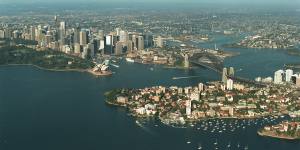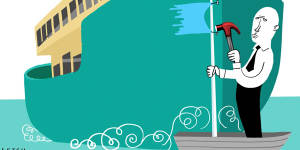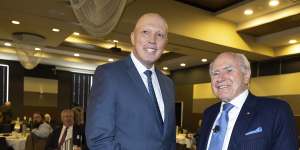Not only are they among the richest electoral divisions in the land,three of these seats,of course,were formerly held by recent Liberal prime ministers,John Howard,Tony Abbott and Malcolm Turnbull. Throw in Bronwyn Bishop’s old bailiwick of Mackellar,lost by a Liberal candidate for the first time in the seat’s history at last year’s election,and the party’s shoreline problem stretches even further north,to the Barrenjoey lighthouse at Palm Beach.

Once the Liberal heartland:Peter Dutton cannot hope to be prime minister without reclaiming critical seats on Sydney Harbour.Ken James
It is hard to see the Liberal Party regaining power without retaking at least some of these onetime conservative citadels. To move from opposition leader to prime minister,then,Peter Dutton almost certainly has to pass what might be called the Sydney Harbour test.
Six out of eight of these shoreline seats are held by women. They speak of the gender gap that the Liberals have long struggled to bridge. The teal revolution was primarily a female phenomenon. Nationally,in every age group,a majority of women preferred Labor over the Liberals. Women aged between 35 and 54 were most likely to turn their backs on the party. As the Liberals’ election post-mortem highlighted,in divisions with high numbers of female professional voters,the party now holds only three of the top 30 seats. Previously it could count 15.
Dutton has made his name as a political hard man. In demeanour and approach,he has always reminded me of the old Thatcherite right-winger Norman Tebbit,who was among the most bruising politicians of a particularly bruising era. So it is difficult to see professional women warming to Dutton in big numbers,however much the former policeman tries to smooth the edges of his image.
Sydney’s shoreline seats remind us of the greening of Australian politics,and of how a driving force behind the teal revolution was a determination to preserve their stunning natural beauty. Again,this is not political terrain in which Dutton will thrive. Indeed,by opposing the Albanese government’s 43 per cent emissions reduction target,he seemed determined to prolong the climate wars rather than to seek an armistice.
Divisions such as North Sydney,Wentworth and Warringah were also ground zero for the “kitchen table”,community-based activism that has become such a hallmark both of local and national politics since the lockdowns of the coronavirus.
Many of the volunteers who donned teal T-shirts not only want federal politicians to be more responsive but for federal politics to be more constructive. They were fed up with culture warriors like Scott Morrison,whose priority interest seemed to be in winning for the sake of winning,and weary of fabricated wedge issues which sought to pit Australian against Australian. Again,Dutton defies the zeitgeist. Throughout his career,he has personified the politics of polarisation.
Finally,these seats are the spiritual and residential home of the leaders of corporate Australia,a group which Dutton maligned in a last year for espousing values more in line with Labor and the Greens.
Evidently,Dutton believes the Liberals should be the party of the battlers rather than a big end of town that has become excessively woke. However,an electoral strategy centred on the western suburbs,using a Howard-era field guide,is not going to endear him to the Turnbull conservatives of the eastern suburbs.

Illustration:Simon Letch
If Dutton is truly serious about softening his image and repositioning himself politically,an obvious path is open to him. Endorsing the Indigenous Voice to parliament,the most emblematic issue of the day,would show his willingness to pursue a more constructive form of politics,and signal a welcome ceasefire in the culture wars.
From a politician who boycotted Kevin Rudd’s national apology to the Stolen Generations,it would demonstrate maturity,growth and change. Yet the signs are not good,judging by the 15 questions Dutton posed to Anthony Albanese seeking clarity on a referendum asking voters to support a principle rather than a specific design.
Evidently,winning back the shoreline seats is not an urgent priority. Maybe Dutton has come to view the harbourside as woke central,an area with inner-west leanings but higher property prices. Well-heeled greenies who can afford to drive Teslas. A professional,highly educated urban elite looking to expiate its sense of white guilt in the Voice referendum.

Opposition Leader Peter Dutton and former prime minister John Howard.Alex Ellinghausen
The problem here is that Dutton can ill-afford to write off too many areas because the Liberal Party is surveying a pretty barren national electoral map. Not only is it the old blue-ribbon seats of Sydney. Equally,we could have spoken of his Kooyong conundrum,the need to regain Sir Robert Menzies’ conservative citadel,or his West Australian dilemma.
Peter Dutton not only runs the risk of placing himself on the wrong side of history on Uluru,but also ignoring the here and now of Australia’s new political geography. Currently,he looks to be failing the Sydney Harbour test.
The Opinion newsletter is a weekly wrap of views that will challenge,champion and inform your own..